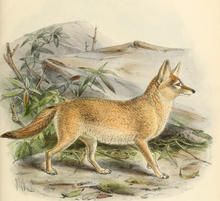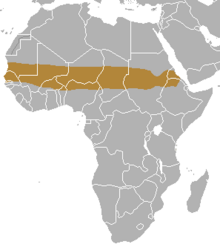Pale fox
| Pale fox[1] | |
|---|---|

| |
| Scientific classification | |
| Kingdom: | |
| Phylum: | |
| Class: | |
| Order: | |
| Family: | |
| Genus: | |
| Species: | V. pallida
|
| Binomial name | |
| Vulpes pallida (Cretzschmar, 1827)
| |

| |
| Pale fox range | |
The pale fox is a species of fox found in the band of African Sahel from Senegal in the west to Sudan in the east.[1][3] It is one of the least studied of all canid species, in part due to its remote habitat and its sandy coat that blends in well with the desert-like terrain.[4]
Subspecies
There are five recognized subspecies:[1]
- Vulpes pallida pallida
- Vulpes pallida cyrenaica
- Vulpes pallida edwardsi
- Vulpes pallida harterti
- Vulpes pallida oertzeni
Description
The pale fox is long-bodied with relatively short legs and a narrow muzzle. It is a relatively small canid with weight ranging from 4 - 6 pounds. The ears are large compared to other foxes but is typical of a desert inhabiting canid. The fur is generally a pale sandy color that turns white towards the belly. Its bushy tail is reddish brown and black at the tip.[4]
Distribution and habitat
The pale fox is native to the Sahel, the semi-arid regions to the south of the Sahara Desert. It is present in Benin, Burkina Faso, Cameroon, Chad, Eritrea, Ethiopia, Gambia, Mali, Mauritania, Niger, Nigeria, Senegal, South Sudan and Sudan. The habitat is sandy or stony arid terrain, and the pale fox is able to relocate southwards and northwards in relation to the periodic droughts that affect these regions.[2]
Ecology
The pale fox is typically inhabits stony deserts and semi-deserts although it occasionally ventures south into the savanna. It lives in small family groups with parents and their young. During the day they rest in dug burrows that can extend up to 15 meters long and descend up to 2 meters to the ground, at dusk they venture out and forage for food, which includes plants and berries as well as rodents, reptiles and insects. It has the ability to retain water from its food, and can go almost completely without drinking.[4]
Status
Although the abundance of the pale fox is unknown, it seems to be a common species throughout its wide range. No particular threats have been identified although this fox is sometimes hunted because it raids villages and takes poultry, and it is sometimes killed by vehicles at night. The International Union for Conservation of Nature has rated its conservation status as being of "least concern".[2]
References
- ^ a b c Wozencraft, W. C. (2005). "Order Carnivora". In Wilson, D. E.; Reeder, D. M. (eds.). Mammal Species of the World: A Taxonomic and Geographic Reference (3rd ed.). Johns Hopkins University Press. pp. 532–628. ISBN 978-0-8018-8221-0. OCLC 62265494.
- ^ a b c Template:IUCN2015.2
- ^ "Pale fox (Vulpes pallida)". Canid Specialist Group. Retrieved 20 November 2016.
- ^ a b c "Arkive - Pale fox". 2006. Retrieved 20 November 2016.
- Walker's Mammals of the World, Fifth Edition,volume 1, Johns Hopkins University Press

